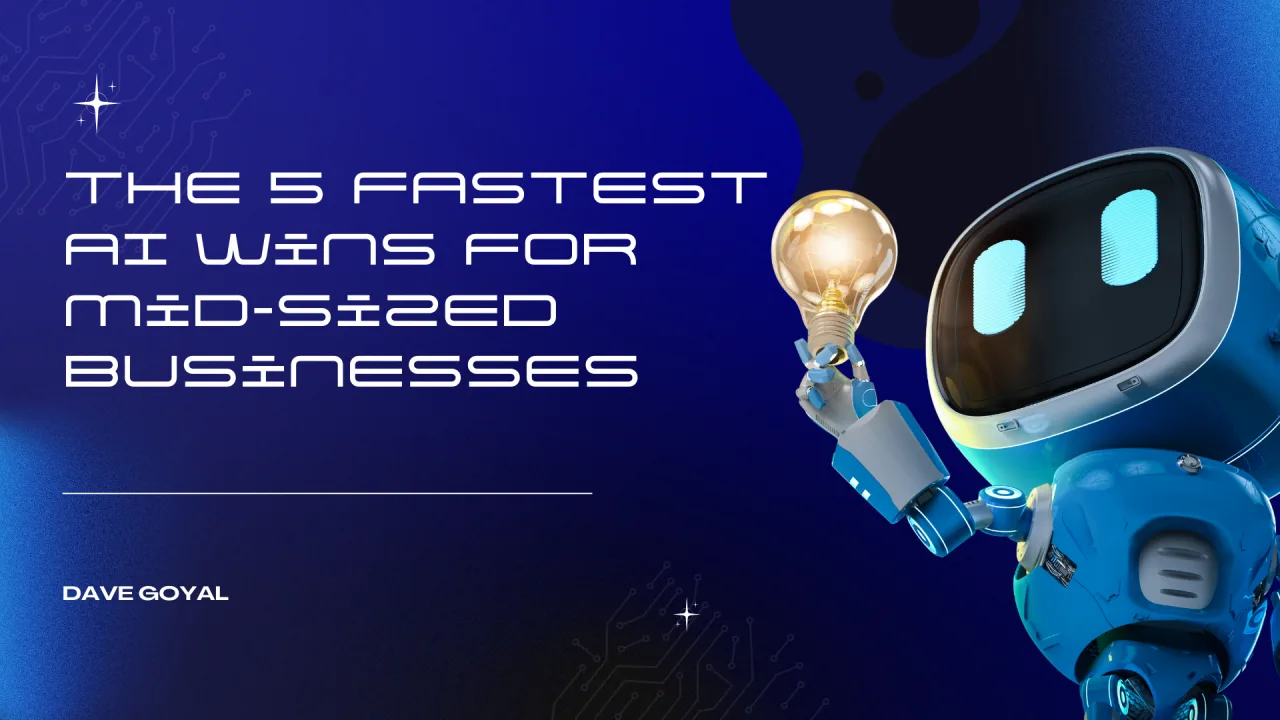Artificial intelligence is no longer a futuristic project for Fortune 500 firms. Mid-sized businesses are finding that some of the fastest and most affordable gains come from targeted pilots. The trick is to start where data is ready, volume is high, and off-the-shelf tools exist.
In this article, we look at five proven AI use cases that deliver results in weeks, not years: invoice automation, AI customer service, predictive lead scoring, inventory optimization, and knowledge Copilots.
1. Automated document and invoice processing
What it is AI document processing combines optical character recognition with pretrained models to read invoices, purchase orders, and contracts. The system extracts key fields and routes them directly into accounting or ERP workflows.
Why it is a quick win Invoices are structured or semi-structured, and vendors now offer ready integrations with popular finance platforms. Even a small pilot, focused on one supplier or invoice type, can deliver measurable savings.
Case in point Canon processed about 40,000 invoices in under nine months with UiPath Document Understanding. The project achieved roughly 90 percent straight-through processing, saving thousands of hours in accounts payable.
Pilot checklist
- Gather sample invoices across formats.
- Baseline current cycle time and exception rates.
- Run a vendor pilot with human review.
- Measure straight-through processing improvement.
Key metric: straight-through processing rate and reduction in manual exceptions.
2. AI-powered customer service
What it is Generative AI and intent classification can deflect simple queries, draft agent replies, and route complex cases to humans. Think of it as a virtual support team that handles FAQs while live agents focus on higher-value work.
Why it is a quick win Most companies have a small set of issues that generate most support tickets. Automating answers for the top 10 queries can cut workload and improve customer satisfaction immediately.
Case in point Lush implemented Zendesk and achieved a 369 percent ROI according to Nucleus Research. Payback came in under a year, with noticeable improvements in agent productivity.
Pilot checklist
- Identify top ticket categories by volume.
- Connect knowledge base articles for retrieval.
- Start by assisting agents with draft responses.
- Track deflection rate, CSAT, and escalation quality.
Watch out: generative models can hallucinate. Keep humans in the loop and update knowledge sources often.
3. Predictive lead scoring and sales prioritization
What it is Machine learning models analyze CRM history and engagement data to predict which leads are most likely to convert. Sales reps then focus time on the highest-potential accounts.
Why it is a quick win All the necessary data lives in CRMs, and most major CRMs now include predictive scoring features. That reduces the need for custom integration and accelerates rollout.
Evidence of impact HubSpot and Salesforce highlight how predictive scoring helps sales teams close deals faster. Independent case reports suggest conversion rate improvements of 20 to 40 percent when reps focus on high-scoring leads.
Pilot checklist
- Clean CRM data and label past opportunities.
- Run a blind test comparing model scores to rep picks.
- Route high-scoring leads into fast-response workflows.
- Track conversion lift and sales cycle reduction.
Key metric: increase in lead-to-deal conversion.
4. Inventory optimization and demand forecasting
What it is AI forecasting models predict demand and dynamically adjust reorder points and safety stock. The result is fewer stockouts and less capital tied up in excess inventory.
Why it is a quick win Retailers and distributors already collect sales and POS data. Piloting AI forecasting on the top 20 SKUs can prove value within a single replenishment cycle.
Case in point Vendors like Blue Yonder report measurable improvements in inventory turnover and fill rates. Retailers have seen reductions in out-of-stock events and improved promotion planning.
Pilot checklist
- Select top SKUs by revenue or margin.
- Compare AI forecasts to existing reorder logic.
- Implement dynamic safety stock.
- Measure fill rate and days of inventory.
Key metric: reduced stockouts and improved fill rate.
5. Knowledge management and employee productivity
What it is AI assistants powered by retrieval augmented generation help employees search internal documents, SOPs, and ticket history. They can also summarize content and draft emails or reports.
Why it is a quick win Most companies already store knowledge in SharePoint, Confluence, or help desk systems. Modern tools connect directly, making it easy to deploy an assistant for one team.
Evidence of impact Microsoft reports that Copilot features help employees draft documents and answer questions more quickly. Organizations using retrieval and summarization assistants see measurable gains in onboarding speed and knowledge access.
Pilot checklist
- Audit where knowledge lives and add metadata.
- Build a small assistant for one department.
- Require human review during early rollout.
- Track time saved in finding or summarizing information.
Key metric: time-to-proficiency for new hires and employee time saved per knowledge task.
A simple 90-day pilot playbook
If you are ready to test one of these five use cases, here is a simple plan:
- Week 0: Pick a use case with high volume and available data.
- Weeks 1–4: Gather samples, baseline current performance, and run a minimum viable pilot.
- Weeks 5–8: Iterate and refine integration.
- Weeks 9–12: Measure ROI and prepare to scale.
Conclusion
Mid-sized businesses do not need to reinvent AI. The fastest wins come from projects that replace repetitive tasks, improve frontline productivity, and use data you already have. Start small, measure carefully, and scale once you see proof. With the right pilot, you can deliver tangible savings and a stronger customer experience within a single quarter.
Click here to read this article on Dave’s Demystify Data and AI LinkedIn newsletter.

